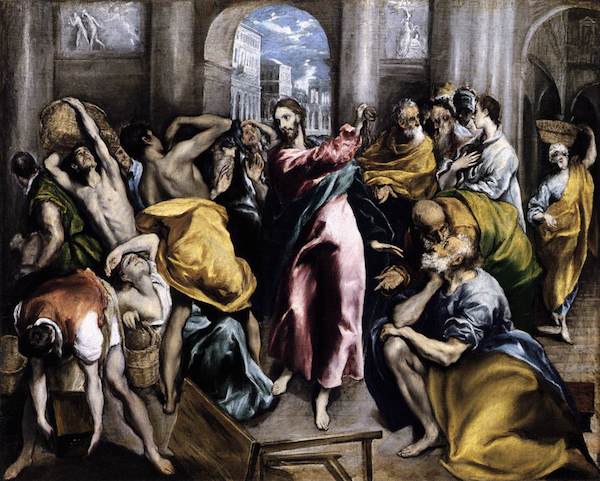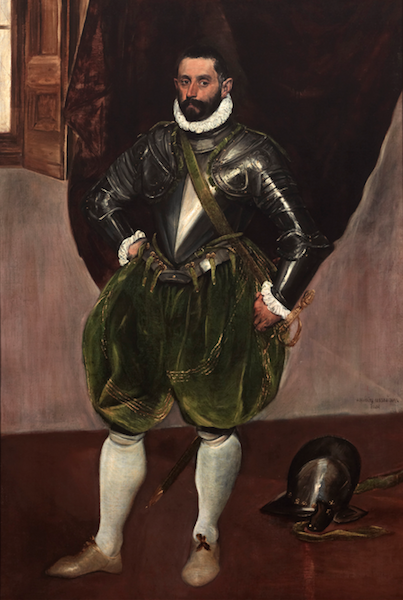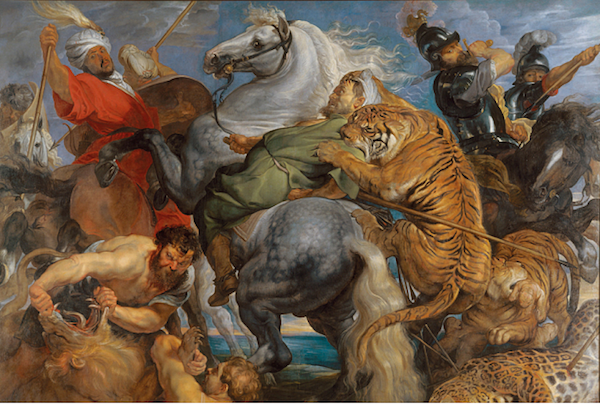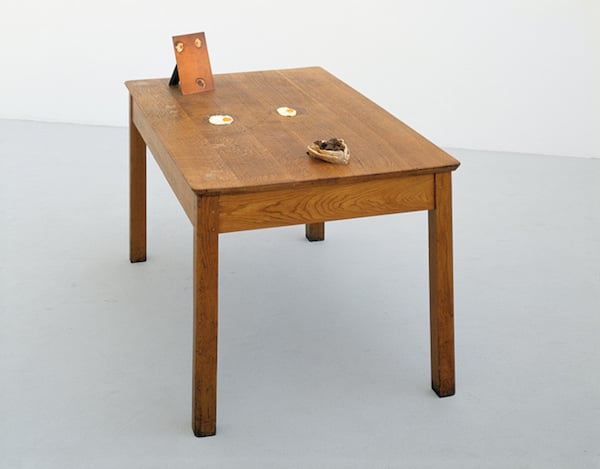Art & Exhibitions
El Greco, Rubens, and Why We Should Stop Re-Inventing Old Masters
Please leave Sarah Lucas out of this.

Please leave Sarah Lucas out of this.

Edward Lucie-Smith

Recently I was in New York, and the party I was with had the privilege of a special visit to the Frick Collection, in many ways the grandest of all New York museums (see Former Frick Director Speaks Out Against Expansion Plan and Frick Garden Was Meant to Be Permanent). The Frick is what it is—it doesn’t play the populist card. In a very real sense, what you see is what you get. (See Let the Frick Be.) It doesn’t lend what it owns (at any rate not the works given to it by its founder, Henry Clay Frick), but on this occasion it was playing host to a group of paintings lent by another grandee institution, the National Galleries of Scotland.
The pictures were well spaced out, in big but not overwhelmingly large rooms. Even though it was winter, many—though not all—were lit by natural light, coming into the galleries through huge skylights. They were very even in quality, superb works by big names. Among the paintings on view, grouped together, were the three El Grecos that belong to this institution.
One is a subject picture, The Purification of the Temple (c.1600). Another is an image of St. Jerome, seated in his study (perhaps a little earlier than 1600). The third is much earlier, circa 1575: a portrait of Vincenzo Anastagi, wearing armor. It dates from the end of El Greco’s somewhat unsuccessful period in Rome—he lived there from 1570 to 1576. Anastagi was appointed sergeant major of Rome’s Castel Sant’Angelo in 1575.
Once I wriggled free of the tour I was inspired to go just a little farther up Fifth Avenue, to the Metropolitan Museum, which was offering a special display of all the other El Grecos held in New York City collections, brought together to celebrate the 400th anniversary of El Greco’s birth. There were 10 paintings from the Met itself, and six more from the Hispanic Society of America. Everything on view dated from El Greco’s time in Rome or in Spain. There was nothing from his time as a painter of icons in Crete (a signed example survives in a church on the Greek island of Syros) and nothing from his years of apprenticeship in Venice, where he arrived around 1567. In Venice he was influenced by the work of Tintoretto, and also by prints made after the work of other Italian Mannerist artists, such as Parmigianino. (See Cracking the Parmigianino Code at the Frick.)

El Greco, Vincenzo Anastagi (ca. 1575)
Photo: Courtesy Michael Bodycomb/ The Frick Collection, New York
The curator Walter Liedtke, whose last project for the Metropolitan Museum this was (see Tragedy as Metropolitan Museum Curator Walter Liedtke Killed in Metro-North Train Crash), noted that the event was “fascinating as a reflection of sophisticated New York taste at a particular moment, about 1900-20. The enthusiasm of critics and of modern painters such as Cézanne, Picasso, and the German Expressionists inspired the Met itself and its great benefactors (such as the Impressionist collectors Henry and Louisine Havemeyer) to bring great works by El Greco to America shortly after his ‘rediscovery’ in Spain.”
Liedtke also noted that El Greco’s Vision of St John, perhaps the most radical of all the works on display at the Met “remains the most extraordinary thing, as it was for artists ranging from Picasso as he painted Les Demoiselles d’Avignon to Jackson Pollock in a series of drawings after the apocalyptic scene.”
In fact, the display in New York offered a striking example of the way both scholar commentators and the broader lay audience tend to make over the art of the past in order to conform to the tastes and feelings of their own epoch. This was a point well made by Michael Glover, in a piece published two years ago in The Independent. He compared El Greco’s work to “the canvases of Peter Doig, finished enough but never too much.” He added: “We want to be reminded that canvases are made things. Old-fashioned illusionism feels too pat, a species of fakery […] We like this feeling of being on the cusp of revelation amidst bodies that seem to be moving towards their full identities, their full shapeliness.” And then he lets a cat out of the bag: “What is more, the whole thing was brutally trimmed down during its ‘restoration’ in 1880. A whole section of the upper sky was removed. ‘Good,’ we think to ourselves. We quite like how that sky seems to be closing in on the squirming fingers of St John.” In other words, this was not the composition as the artist intended it, but one fairly radically altered to suit the tastes of posterity. No wonder the modern audience rates it so high.
The notion that “canvases are made things” is in any case returning among young British painters with something of a vengeance. A good example was the solo show of virtuoso figurative paintings by 25 year-old Bartholomew Beal, held at the Fine Art Society in Bond Street, in the middle of last year. The exhibition sold out.
El Greco re-invented as a Post-Impressionist avant la lettre, or even as a proto-Expressionist, seems a comparatively innocent kind of process. All creative generations tend to do that to their predecessors. We particularly like to embrace artists who somehow seem a bit odd when placed in their historical context. Posthumous justice seems to be done when we welcome an El Greco or a Caravaggio into our contemporary pantheon, giving them a rank that was not fully theirs in their own day.
This impulse has, however, been carried a little far in a number of recent exhibitions. A case in point is the “Rubens and His Legacy” exhibition in the main galleries of the Royal Academy (see Newly Authenticated Rubens Heads to the Royal Academy). Originally presented in Brussels, the show now has a tacked-on, not-in-the-catalogue addendum of works selected by the YBA generation artist Jenny Saville. Its aim is to demonstrate that the great Fleming is really one of us—a peer of Francis Bacon, Lucian Freud, Willem de Kooning and Andy Warhol. A number of reviewers have hailed this addition as one of the best things about the show, “bringing Rubens closer to us.”

Peter Paul Rubens, Tiger, Lion and Leopard Hunt (1616)
Photo: Courtesy artfund.org
Prominent in this additional display is a three-dimensional object by Sarah Lucas. Entitled Two Fried Eggs and a Kebab, it was made as long ago as 1992. It is a table turned into an image of a naked woman, with a painter’s palette for a head, fried eggs for breasts and a kebab for genitalia. In other words, a rather brutal feminist comment on the “controlling gaze” attributed to male painters and photographers of the female nude.
The main exhibition, though not as rich as it might be in original works by Rubens, does as it happens offer one of two examples of the kind of Old Master composition that feminists, perhaps with some justice, now object to. There is a small entirely autograph painting by Rubens entitled The Hermit and the Sleeping Angelica, It shows a gnarled old man drawing aside a covering to expose a plump young woman, asleep, totally naked, and innocently unaware that she is being displayed for all the world to see. Exquisitely painted, it is a gleeful celebration of voyeurism. Hung close beside it, there is an unusually powerful Watteau of a similar subject.
Whatever the moral weighting, guilty Rubens and equally guilty Watteau win the aesthetic contest hands down. Look at these two masterful paintings, then at Lucas’s tacky construction, and the thought rises unbidden: “Oh, for God’s sake, get over it.” One also thinks: “Is this really the best our contemporary visual culture can offer?” Not, I think, the reaction the exhibition organisers wished to produce (see “Impolite” YBA Sarah Lucas Will Represent Britain at the 2015 Venice Biennale).

Sarah Lucas, Two Fried Eggs and a Kebab (1992)
Photo: Courtesy Saatchi Gallery
The small El Greco show at the Met and the big Rubens occasion at the Royal Academy do have one thing in common. Both are didactic. One somewhat covertly so; the other quite openly. Liedtke’s aim in curating this display of El Grecos, drawn entirely from New York collections, was not simply to celebrate the painter. It was also to celebrate the evolution of American taste, and to link this evolution to the 20th century triumph of American art. Hence the pointed citation of Pollock in the accompanying text.
The Rubens show plods on leaden feet through the story of Rubens’ influence on other artists, chief among them the 19th-century Romantics. There is a plentiful display of rather second-rate works that are not by Rubens, and rather too many reproductive engravings. Arranged thematically, some of the galleries efficiently deliver their point (a good one to begin with about Rubens’ influence of British landscape painting–Constable in particular). Others just don’t. This is an exhibition conceived as an old-fashioned lecture-with-slides, presented just at the moment when that kind of thing, thanks to the cyber-revolution, is going out of date. It doesn’t invite us to enjoy, it instructs us to listen carefully to what the prof has to tell us. Examination paper to follow–tick answers ‘yes’ or ‘no’ as appropriate. Score less than 50% and, no, you can’t have a coffee in the Royal Academy cafeteria.
The El Greco show at the Met is much smaller, but everything in it is by El Greco. Despite its covert didacticism it delivers a concentrated jolt of pleasure that is absent at the R.A.